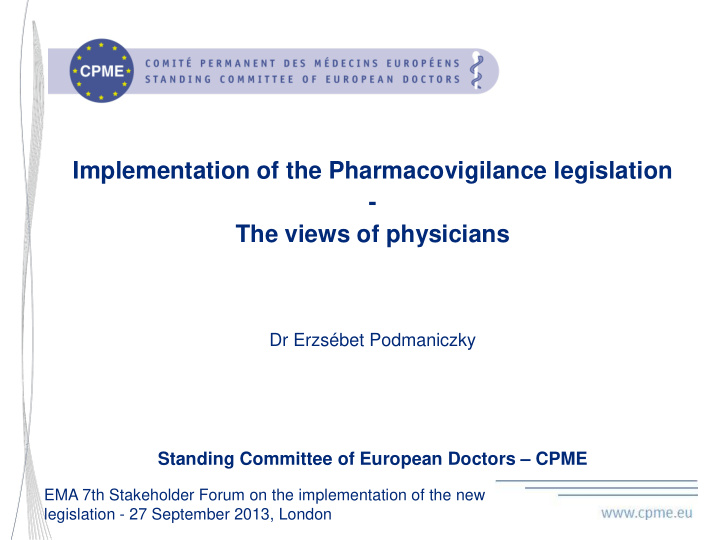



Implementation of the Pharmacovigilance legislation - The views of physicians Dr Erzsébet Podmaniczky Standing Committee of European Doctors – CPME EMA 7th Stakeholder Forum on the implementation of the new pharmacovigilance legislation - 27 September 2013, London
Standing Committee of European Doctors – CPME • Founded in 1959, CPME has been promoting for more than half a century the highest standards of medical training and medical practice in order to achieve the highest quality of healthcare for all patients in Europe. • We are committed to contributing the medical profession’s point of view to EU and European policy-making through pro-active cooperation on a wide range of health and healthcare related issues. • We are concerned with the promotion of public health, the relationship between patients and physicians and the free movement of physicians within the European Union.
CPME activities in the field of Pharmacovigilance • CPME represented in the EMA HCP WP • CPME General Assemblies (twice a year) • CPME Working group on Pharmaceuticals (twice a year + webmeetings) • Email communications • Public consultations (EMA policy on publication of clinical trial data ; black symbol)
CPME Expectations on Pharmacovigilance (I) Better reporting of ADRs by HCPs, notably physicians • • Directive 2010/84 - Art. 102 : “The Member States shall take all appropriate measures to encourage patients, doctors, pharmacists and other healthcare professionals to report suspected adverse reactions to the national competent authority; for these tasks, organisations representing consumers, patients and healthcare professionals may be involved as appropriate” • Measures to properly involve physicians are essential
CPME Expectations on Pharmacovigilance (II) Physicians need: Better acces to PhV and safety data • Better information and training • • Better use of technological advances • Better involvement of associations of professionals • Better feedback from authorities to the reporting physicians
Reflections on communication achievements • Communication of the EMA is outstanding • Feedbacks from National Medical Associations: – Finnish Medical Association (FMA) “in Finland the EMA has not been very visible, however the national medicines agency FIMEA has keenly worked according to the EMA and the Directive mainstream” – German Medical Association (GMA) : Joint workshop BfArM and PEI; regular exchanges between the GMA, BfArM and PEI – Danish Medical Association (DMA) involved since 2009 in strengthening pharmacovigilance
The Danish Case (I) • Since 2009, two national action plans on PhV in close collaboration between the Danish Health and Medicines Agency (SST) and the Danish Medical Association (DMA). The DMA is represented at the Danish Medical Council on PhV • Measures to facilitate the reporting of adverse drug reactions by physicians: - Simple electronic reporting systems: http://laegemiddelstyrelsen.dk/en/topics/side-effects-and-trials/side- effects.aspx - Side effect managers - Feedbacks from SST to the industry and physicians - Direct feedbacks from SST to each reporting physician - Information campaigns
The Danish Case (II) • Very positive outcome: increase of the ADR reportings by physicians But there is still room for improvement: • – Financial barriers to the full implementation of the side effect manager; – Work overload of physicians – burnout situations -> reduce the reportings • Further incentives are needed, but the Danish case is a good example to go forward and increase reporting of ADRs by physicians !
Thank you for your attention! Dr Erzsébet Podmaniczky Standing Committee of European Doctors Rue Guimard 15, 1040 – Brussels, Belgium Tel: +32 2 732 72 02 www.cpme.eu
Recommend
More recommend